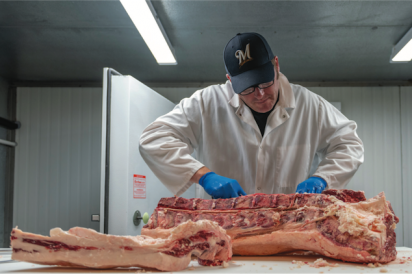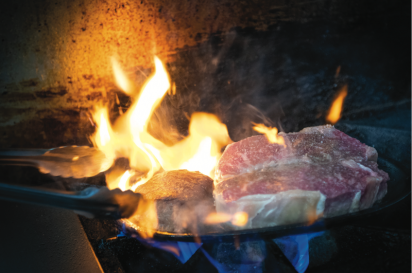The Art of Aging
Why do we love steak so much? Why is it simultaeously the quintessential celebration food and a go-to comfort food for almost all meat-eating Westerners? Is it because it is the best tasting of all the animal proteins? No. Far from it.
If you cooked a chicken breast, a pork chop and a beef tenderloin filet without seasoning at the same time in a dry oven, the results would harken the bellow of a sad trombone. While all three would be equally uninspired, bland and depressing, you might be surprised to find that the chicken would still taste like chicken and the pork like pork. But the steak would taste oddly not like steak. It would have a minerally, tinny, 'side-of-the-tongue' bitterness that would check none of the beef boxes of char, beef, fat or savory.
And that is because for steak to taste good it needs a little help from some very key components. First, it needs salt and pepper. And only salt and pepper. Don't overreach with some sort of "Montreal" steak seasoning (whatever that is) or your local grocery store's "Texas Mesquite Smokehouse Northwoods Cajun Creole Groll Rub." Fresh, finely ground black pepper and large flake Kosher salt is all you need.
The next most important ingredient is perhaps less commonly known among the casual grill master or home cook: the Maillard Reaction, or browning. Beef is one of those proteins that just doesn't work without some caramelization. The Maillard Reaction is a chemical reaction between amino acids and reducing sugars that creates the dark color we associate with steak. More importantly, it's what makes it taste like steak.
There's one other critical ingredient, however, that makes this center-of-the-plate protein so prized...time. And it is the addition of this ingredient that brings steak to another level of enjoyment and price. Given the stigma associated with spoiled food, we use a nice-sounding word to describe the process of letting meat sit for weeks and perhaps months before eating it: aging. But is it just semantics? What's the difference between aging and decay?
All living things are comprimised of protein, carbs and fat which have little, if any, flavor of their own. Effective, sanitary aging of meat happens under conrtolled temperature and controlled humidity where the enzymes and molecules that exist in food transform those bland building blocks into something with sweetness, tartness, bitterness and savory-ness, much the same way a tomato ripens on your kitchen counter.
"Meat is 80% water, so by allowing some of that water to evaporate from the meat, we create greater concentrations of the beef flavonoinds," said Joe Parajecki, Operations Manager at Kettle Range Meat Co. at 5501 W State Street in Milwaukee. "Another reason is that each dry-age cooler is its own micro-climate where certain fungal species grow."
Given the urgeny to process, package and sell meat, it is seldom afforded an opportunity to develop beyond its rawest form. When processors create these conditions, they enable the enzymes to do their work--and end up with a complexity of flavor that just wasn't there before.
"This is not spoilage," Parajecki continues, "by controlling the temperature and humidity in the dry aging room, we allow the meat to age rather than rot. We have had meat in our dry-aging cooler from 30 days all the way to 120 days and beyond. We have salt blocks to control mold growth; salt is antiseptic and actually kills the bad fungi that may enter our cooler."
In other words, don't try this at home.
At Carnevor Steakhouse, located on 718 North Milwaukee Street in downtown Milwaukee, steak is serious business. The Surg Restaurant Group takes the concept of 'control' to a whole other level by raising the animals themselves. Hidden Creek Farm in New London, Wisconsin (owned by Surg) is home to a herd of cattle, hogs and chickens that populate the coterie of Surg restaurant menus.
Corporate Butcher Jed Hunter receives three cows per week at their Milwaukee Street processing facility. Here, he turns whole animals into the varied cuts requested by the brigade of Surg chefs. Among them, a boneless ribeye found on the menu at Carnevor that undergoes a forty-day aging process and comes with an $85 price tag.
When it arrives at the table, it sits alone on an oval plate (which it dwarfs). It is a 100% yield steak, which means, you can eat every last morsel of it. No trim, no gristle. The steak is offered with an array of accoutrements to help coat the inside of your mouth such as garlic butter, béarnaise or roasted shallot wine sauce.
I, however, decided to let the steak speak for itself. I'm partial to that outer crust created by high heat and melted salt, so with a giant Carnevor-branded steak knife in hand, I went straight for the edge, curious to see if the outer perimeter was cooked beyond our requested medium rare. It wasn't. The gradient of color was perfectly consistent, end to end. The steak cut like butter--and the tell-tale sign of an extremely high-quality cut--had virtually no purge of blood. The flavor and texture proffered by the 40 days of age were completely unlike that of a 'straight-out-the-fridge' piece of meat. There was a sweetness, a tartness and an indescribable level of umami.
Despite the mainstream appeal and camera-ready allure of filet mignon, most chefs, butchers and foodies agree that the ribeye is the best cut. And they are not wrong. The process for cooking this Jurassic slab of protein is equally pain-staking.
Carnevor Executive Chef Mario Giuliani is a young, slender, unassuming fellow whose journeyman resume doesn't read like that of a well-pedigreed culinary ace. With no culinary school in his past, and stops as quick-service taco chains and local pubs, his assent to the helm of Milwaukee's premiere steakhouse is all the more impressive.
Chef Mario first allows the steak to rest before any cooking begins; sometimes up to an hour. It is generously seasoned with salt and pepper before entering he broiler and not under screamingly high heat. This will be a process. At a temprerature somewhere between 350 and 400 degrees, the steak begins a ballet of twists and turns that will enable even cooking, salt-melting and protein coagulation. Once the steak firms and the internal temperature in reached (determined simply by touch) it is removed from the broiler, where it will rest some more. The purpose of this is to allow the proteins and juices to reconstitute and allow a much slower, lower-heat cooking on the steak's own terms.
Finally, just before it is served, it is re-flashed to make the surface hot, then painted with a palette of butter on its way through the kitchen pass. It is this deceptively simple and consistently executed process that has made Carnevor the place for steaks over the past decade. This attention to detail and unconditional love for an otherwise unspectacular protein has kept diners returning year after year.
Given the time and attention that goes into every one of the steaks on the menu, I couldn't help but wonder how the chefs, farmers and butchers feel when a customer requests that top-tier steak be cooked well-done and served with ketchup. Corporate Chef Jarvis Williams responded succinctly, "We'll do it."








